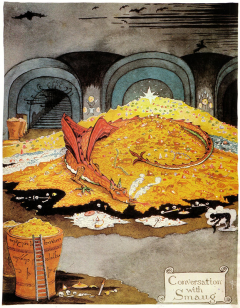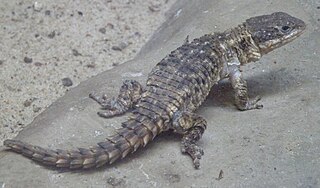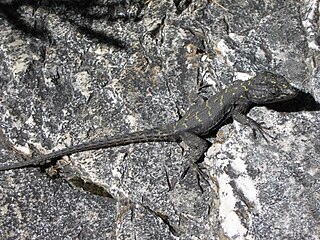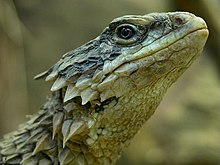
Smaug is a dragon and the main antagonist in J. R. R. Tolkien's 1937 novel The Hobbit, his treasure and the mountain he lives in being the goal of the quest. Powerful and fearsome, he invaded the Dwarf kingdom of Erebor 150 years prior to the events described in the novel. A group of thirteen dwarves mounted a quest to take the kingdom back, aided by the wizard Gandalf and the hobbit Bilbo Baggins. In The Hobbit, Thorin describes Smaug as "a most specially greedy, strong and wicked worm".

The genus Cordylus includes a wide variety of species of small to medium spiny lizards from Africa, collectively called girdle-tailed lizards or girdled lizards. All are diurnal and ovoviviparous. Most species are rupicolous (rock-dwelling), while a few species are arboreal or live in burrows. They defend themselves with osteoderms and by quickly retreating into rock crevices or burrows. Many species live in groups, and males defend territories.

Pseudocordylus is a genus of small to large girdled lizards from South Africa, commonly known as crag lizards. Six species of Pseudocordylus are known; they are distinguished from girdled lizards of the genus Cordylus by the presence of granular scales on the back instead of osteoderms.

The armadillo girdled lizard, also commonly known as the armadillo lizard, the armadillo spiny-tailed lizard, and the golden-armadillo lizard, is a species of lizard in the family Cordylidae. The species is endemic to desert areas along the western coast of South Africa. In 2011, it was moved to its own genus based on molecular phylogeny, but formerly it was included in the genus Cordylus.
J. R. R. Tolkien's Middle-earth legendarium features dragons based on those of European legend, but going beyond them in having personalities of their own, such as the wily Smaug, who has features of both Fafnir and the Beowulf dragon.

The sungazer, also known as the giant girdled lizard, giant dragon lizard, ouvolk, or giant zonure, is the largest species of the Cordylidae, a family of lizards from sub-Saharan Africa. This threatened species is endemic to Highveld grasslands in the interior of South Africa. In 2011, it was assigned to the new genus Smaug, along with seven other species previously belonging to the genus Cordylus, based on a comprehensive molecular phylogeny of the Cordylidae.

The Limpopo girdled lizard, also known commonly as Jones's armadillo lizard and Jones's girdled lizard, is a species of lizard in the family Cordylidae. The species is endemic to Southern Africa.

The Mozambique girdled lizard or flame-bellied armadillo lizard is a large, flattened, girdled lizard found on Mount Gorongosa in Mozambique and low elevations in the Chimanimani Mountains at the border of Zimbabwe and Mozambique. It lives in rock outcrops in grasslands and dry, wooded mountain slopes.
The Rhodesian girdled lizard is one of three species of very flattened girdled lizards from Zimbabwe, Malawi, and Mozambique. The other two species are Cordylus nyikae and Cordylus meculae. They are found living under stones in rock outcrops where they feed on small arthropods. Adults are 60–90 mm long from snout to vent. The tail length is approximately half the total length.

Warren's girdled lizard is a species of relatively large, flattened lizard in the family Cordylidae. The species is native to Southern Africa.

Ninurta coeruleopunctatus, the blue-spotted girdled lizard or simply blue-spotted lizard, is a monotypic genus that is endemic to southern, coastal South Africa.

The false girdled lizard is a lizard species endemic to the Cape Fold Belt of southern South Africa.

Hemicordylus, the false girdled lizards, is a genus comprising two lizard species endemic to the Cape Fold Belt of southern South Africa.
Namazonurus campbelli, commonly known as Campbell's girdled lizard, is a species of lizard in the family Cordylidae. A small girdled lizard, N. campbelli is endemic to Namibia. It is often mistaken for the more common Herero girdled lizard, N. pustulatus, as they both are similar in size and have flattened bodies. N. campbelli lives in rock crevices and cracks on dry mountain slopes

Van Dam's girdled lizard is a species of lizard in the family Cordylidae. The species is endemic to South Africa.

Karusasaurus, commonly known as Karusa lizards, is a genus of lizards in the family Cordylidae.

Namazonurus, is a genus of lizards, commonly known as Namaqua girdled lizards, in the family Cordylidae. The genus contains five species, which are endemic to southern Africa, and feed on insects and small vertebrates.

Smaug breyeri, also known commonly as the Waterberg dragon lizard or the Waterberg girdled lizard, is a species of lizard in the family Cordylidae. The species is endemic to South Africa.















